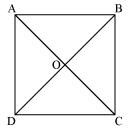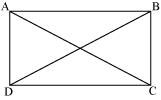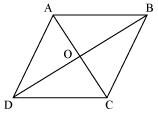Show that the diagonals of a square are equal and bisect each other at right angles.
Let ABCD be a square. Let the diagonals AC and BD intersect each other at a point O. To prove that the diagonals of a square are equal and bisect each other at right angles, we have to prove AC = BD, OA = OC, OB = OD, and ∠AOB = 90º.

In ΔABC and ΔDCB,
AB = DC (Sides of a square are equal to each other)
∠ABC = ∠DCB (All interior angles are of 90)
BC = CB (Common side)
∴ ΔABC ≅ ΔDCB (By SAS congruency)
∴ AC = DB (By CPCT)
Hence, the diagonals of a square are equal in length.
In ΔAOB and ΔCOD,
∠AOB = ∠COD (Vertically opposite angles)
∠ABO = ∠CDO (Alternate interior angles)
AB = CD (Sides of a square are always equal)
∴ ΔAOB ≅ ΔCOD (By AAS congruence rule)
∴ AO = CO and OB = OD (By CPCT)
Hence, the diagonals of a square bisect each other.
In ΔAOB and ΔCOB,
As we had proved that diagonals bisect each other, therefore,
AO = CO
AB = CB (Sides of a square are equal)
BO = BO (Common)
∴ ΔAOB ≅ ΔCOB (By SSS congruency)
∴ ∠AOB = ∠COB (By CPCT)
However, ∠AOB + ∠COB = 180º (Linear pair)
2∠AOB = 180º
∠AOB = 90º
Hence, the diagonals of a square bisect each other at right angles.








